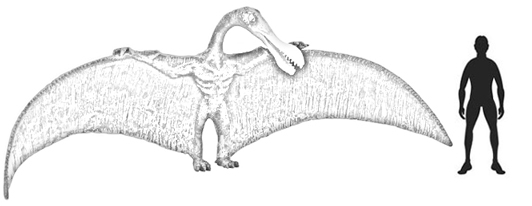Piecing Together Ornithocheirus an Amazing Pterosaur Discovery
The Confusion over Ornithocheirus
The pterosaur known as Ornithocheirus is perhaps more familiar to dinosaur fans than many other types of flying reptile. It appeared in the ground breaking documentary television series “Walking with Dinosaurs”, in fact it was the star of one of the episodes “Beneath a Giant’s Wings”. It is regarded my many as one of the largest pterosaurs known to science with many young dinosaur fans often quoting the text from the many BBC publications associated with the original television series that state that Ornithocheirus was “the size of a small plane”.
Ornithocheirus
As with most aspects of palaeontology the known facts are not permitted to get in the way of a good story. It is true that some exceptionally large pterosaur fossil fragments were found in the Santana Formation of north-eastern Brazil and it was from this evidence that the BBC were able to depict Ornithocheirus as such a huge animal. However, as far as we know those fossils have yet to be fully researched and although they are associated (for the moment), to the Ornithocheirus genus, claims for a twelve metre long wingspan for a member of this particular genus of the pterosauria are doubted by many palaeontologists.
A Drawing of Ornithocheirus
Picture credit: Everything Dinosaur
The trouble with pterosaurs and with Ornithocheirus in particular is the fragmentary and often highly eroded nature of their fossilised bones. The English palaeontologist Harry Govier Seeley was given the task of trying to classify the many hundreds of pterosaur bones that had been found in the Cambridge Greensand deposits of England, a project that he started in 1869. He was commissioned to sort out the flying reptile fossils of the Sedgwick Museum in Cambridge on behalf of the museum itself and Cambridge University. The young, enthusiastic Seeley was beset with problems from the very beginning. These rocks (Cambridge Greensand) represent marine sediments deposited by encroaching sea water over what was to become England during the Early Cretaceous Period.
The highly fragmentary and eroded nature of the fossils has led a number of scientists to conclude that the pterosaur fossils were eroded out of older strata on the sea shore and redeposited. From over 1,000 fossils, Seeley attempted to characterise and classify individual species of Ornithocheirus. His original work has been re-examined by numerous other scientists over the years and something like forty separate species of Ornithocheirus are now listed but most of these are “Nomen dubia” – names given to organisms whose validity is in doubt.
From the fossils discovered to date, Ornithocheirus type pterosaurs were particularly widespread with fossils found in Europe, Australia and Africa, the largest of their kind probably has wingspans of approximately six metres, not the size of a small plane but still large for a pterosaur.
To view models of pterosaurs and other dinosaur toys take a look at “Les Dinosaures” from Papo: Papo Dinosaurs and Pterosaurs.


